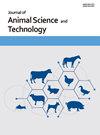饲粮中添加木聚糖酶的非淀粉多糖可提高肉鸡生产性能
IF 3.2
3区 农林科学
Q1 AGRICULTURE, DAIRY & ANIMAL SCIENCE
引用次数: 0
摘要
研究了饲粮中添加非淀粉多糖(NSP)对麦麸替代玉米-豆粕型饲粮中添加木聚糖酶肉鸡生产性能和胴体性状的影响。试验选用280只7日龄罗斯308肉鸡,随机分为5个饲粮处理,每组8个重复,每个栏7只鸡。治疗;i) CON:对照饲粮,ii) CON- x (CON + 3,000 U/kg木聚糖酶),iii) L-X:低NSP (CON中添加2%麦麸+ 3,000 U/kg木聚糖酶),iv) M-X:中等NSP (CON中添加4%麦麸+ 3,000 U/kg木聚糖酶),v) H-X:高NSP (CON中添加8%麦麸+ 3,000 U/kg木聚糖酶)。饲喂H-X日粮的鸟类增加了(<斜体>p</斜体>, lt;0.05)日增重和平均日采食量,体重略有提高(<italic>p</italic>= 0.074)。相对而言,H-X日粮有增加平均日增重的趋势(<italic>p </italic>= 0.053;& lt; italic>术中;/ italic>= 0.073),分别为生长期(d 24 ~ 35)和整个试验期(d 8 ~ 35)。此外,在整个试验期内,不同处理对禽类的饲料转化率无显著影响。饲喂CON-X、L-X和M-X日粮的雏鸟均改善了(<斜体>p </斜体><第24天和第35天回肠能量消化率与H-X日粮相比显著降低(0.05)。此外,饲粮CON-X提高了(< italital>p</ italital>, lt;第24 d N消化率。提高胴体含水率,降低腿肉粗脂肪(<italic>p</italic>, lt;0.05),分别于第35天饲喂M-X和H-X。肠道黏度降低(<italic>p </italic><结果表明,在高NSP(8%麦麸替代水平)饲粮中添加3000 U/kg木聚糖酶可提高肉仔鸡肠道黏度和生长性能。本文章由计算机程序翻译,如有差异,请以英文原文为准。
Feeding dietary non-starch polysaccharides supplemented with xylanase could improve the performance of broilers
The impact of dietary non-starch polysaccharides (NSP) on performance and carcass traits of broilers fed wheat-bran substituted into corn-soybean meal-based diets supplemented with xylanase was investigated. A total of 280 (7-day-old) Ross 308 broilers were randomly allotted to one of five dietary treatments with 8 replicates, 7 chicks per pen. Treatments were; i) CON: Control diet, ii) CON-X (CON + 3,000 U/kg xylanase), iii) L-X: low NSP (2% wheat bran in CON + 3,000 U/kg xylanase), iv) M-X: medium NSP (4% wheat bran in CON + 3,000 U/kg xylanase), v) H-X: higher NSP (8% wheat bran in CON+ 3,000 U/kg xylanase). Birds fed the H-X diet increased (p < 0.05) daily gains, and average daily feed intake and had marginally improved body weights (p = 0.074) on day 35. Relatively, the H-X diet tended to increase the average daily gains (p = 0.053; p = 0.073) of birds during the grower phase (d 24-35) and the entire experimental period (d 8-35), respectively. Moreover, there were no significant differences among treatments in the feed conversion ratio of birds throughout the entire experiment period. Birds fed diets CON-X, L-X, and M-X had improved (p < 0.05) the ileal digestibility of energy on d 24 and 35 compared to those fed the H-X diet. Furthermore, birds fed diet CON-X improved (p < 0.05) N digestibility on d 24. Improved carcass moisture content and lowered crude fat of leg meat (p < 0.05) were noted in birds fed the diet M-X and H-X on d 35, respectively. The intestinal viscosity was reduced (p < 0.05) in xylanase-supplemented treatments CON-X, L-X, M-X, and H-X diets when compared to CON. Our results suggest that supplementing 3,000 U/kg xylanase in a higher NSP (8% wheat bran substituted level) diet could improve the intestinal viscosity and growth performance of broilers.
求助全文
通过发布文献求助,成功后即可免费获取论文全文。
去求助
来源期刊

Journal of Animal Science and Technology
Agricultural and Biological Sciences-Food Science
CiteScore
4.50
自引率
8.70%
发文量
96
审稿时长
7 weeks
期刊介绍:
Journal of Animal Science and Technology (J. Anim. Sci. Technol. or JAST) is a peer-reviewed, open access journal publishing original research, review articles and notes in all fields of animal science.
Topics covered by the journal include: genetics and breeding, physiology, nutrition of monogastric animals, nutrition of ruminants, animal products (milk, meat, eggs and their by-products) and their processing, grasslands and roughages, livestock environment, animal biotechnology, animal behavior and welfare.
Articles generally report research involving beef cattle, dairy cattle, pigs, companion animals, goats, horses, and sheep. However, studies involving other farm animals, aquatic and wildlife species, and laboratory animal species that address fundamental questions related to livestock and companion animal biology will also be considered for publication.
The Journal of Animal Science and Technology (J. Anim. Technol. or JAST) has been the official journal of The Korean Society of Animal Science and Technology (KSAST) since 2000, formerly known as The Korean Journal of Animal Sciences (launched in 1956).
 求助内容:
求助内容: 应助结果提醒方式:
应助结果提醒方式:


